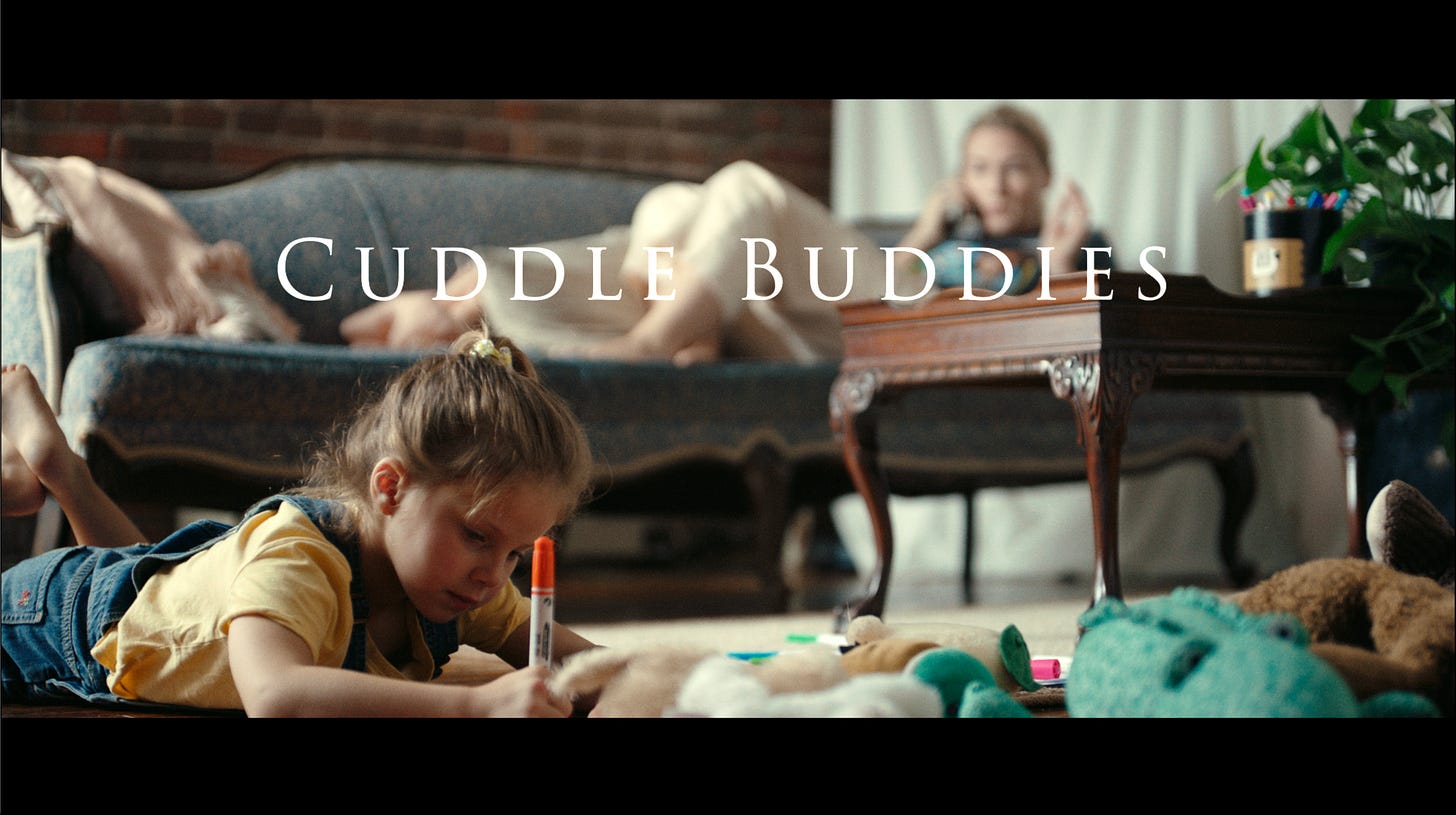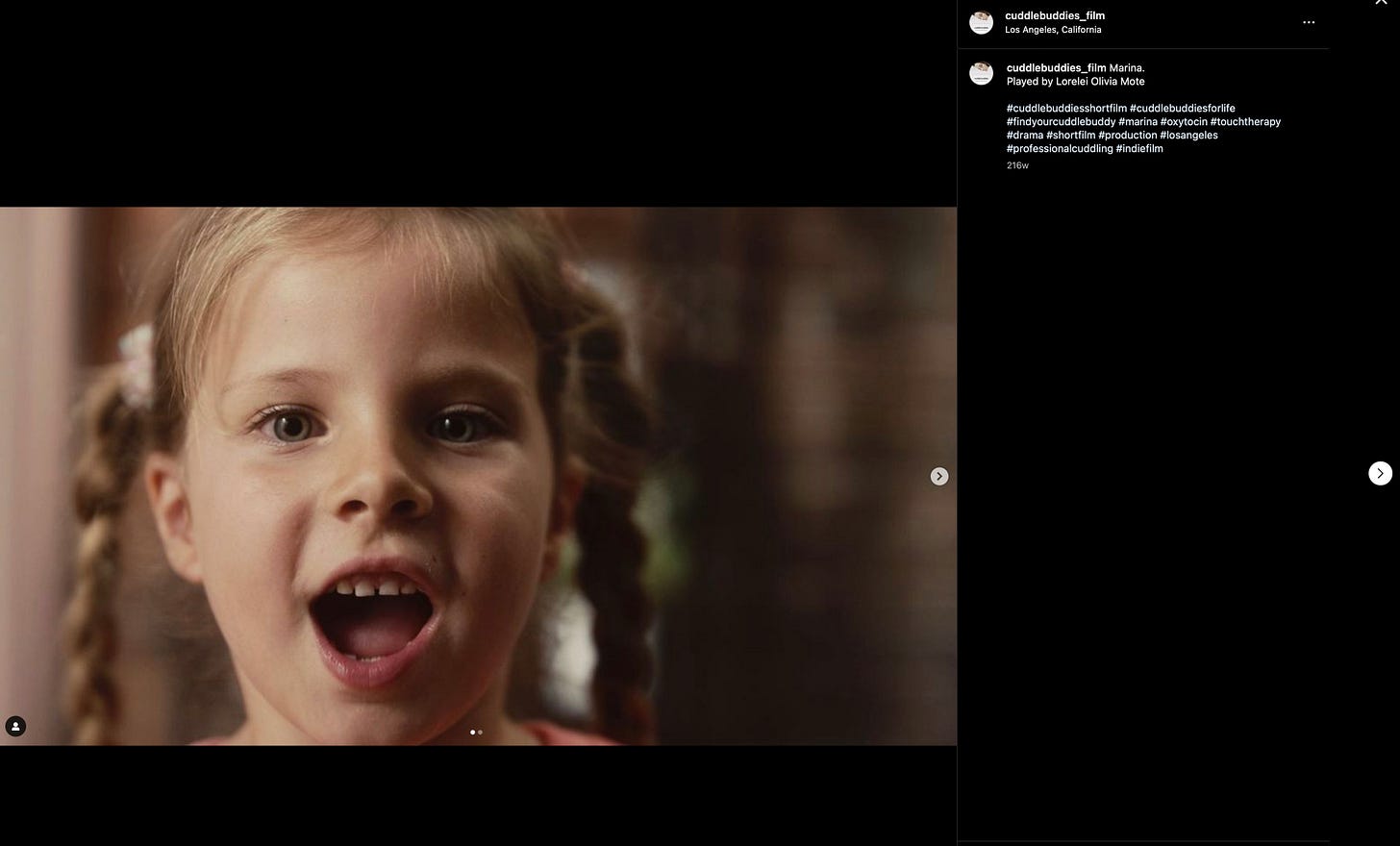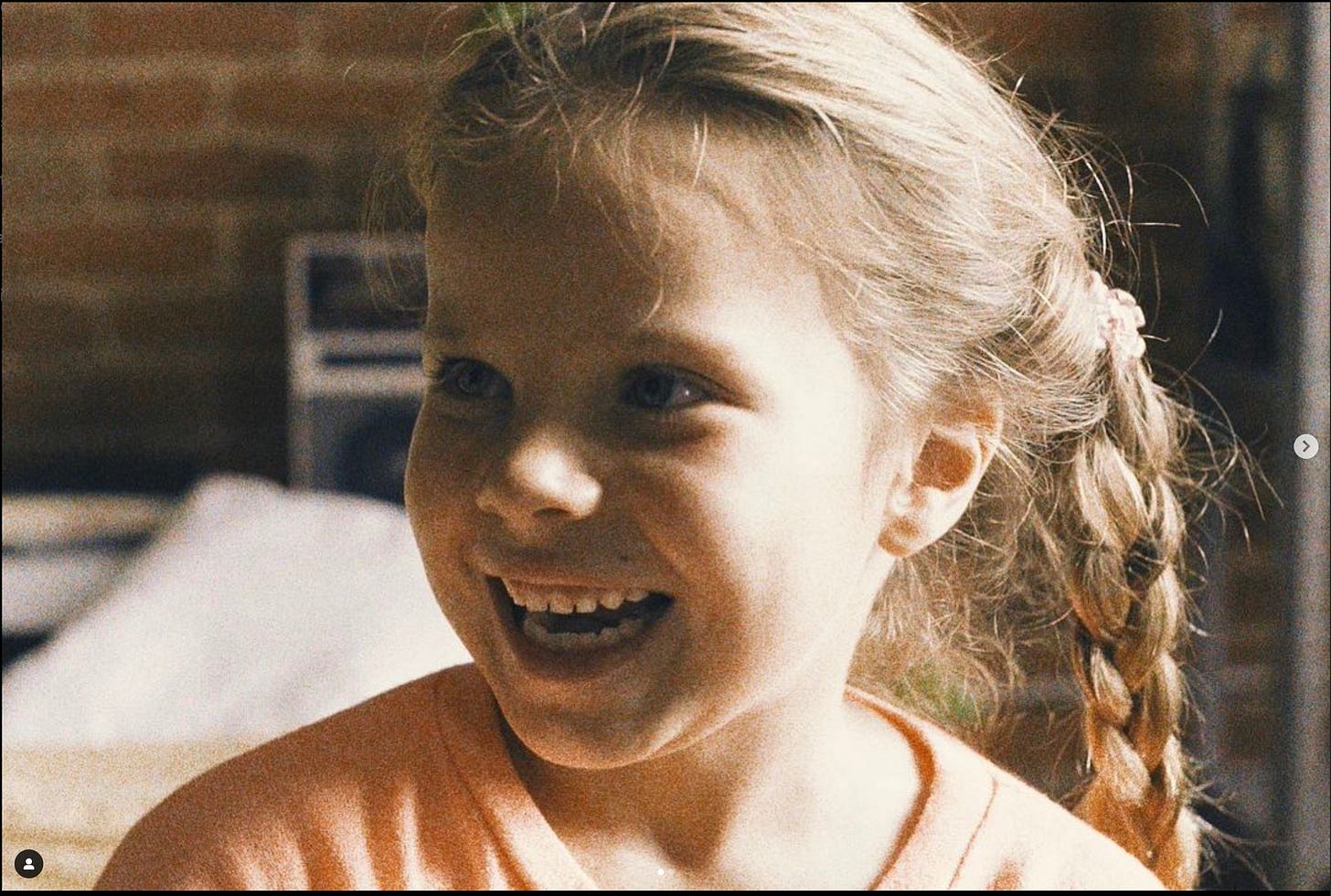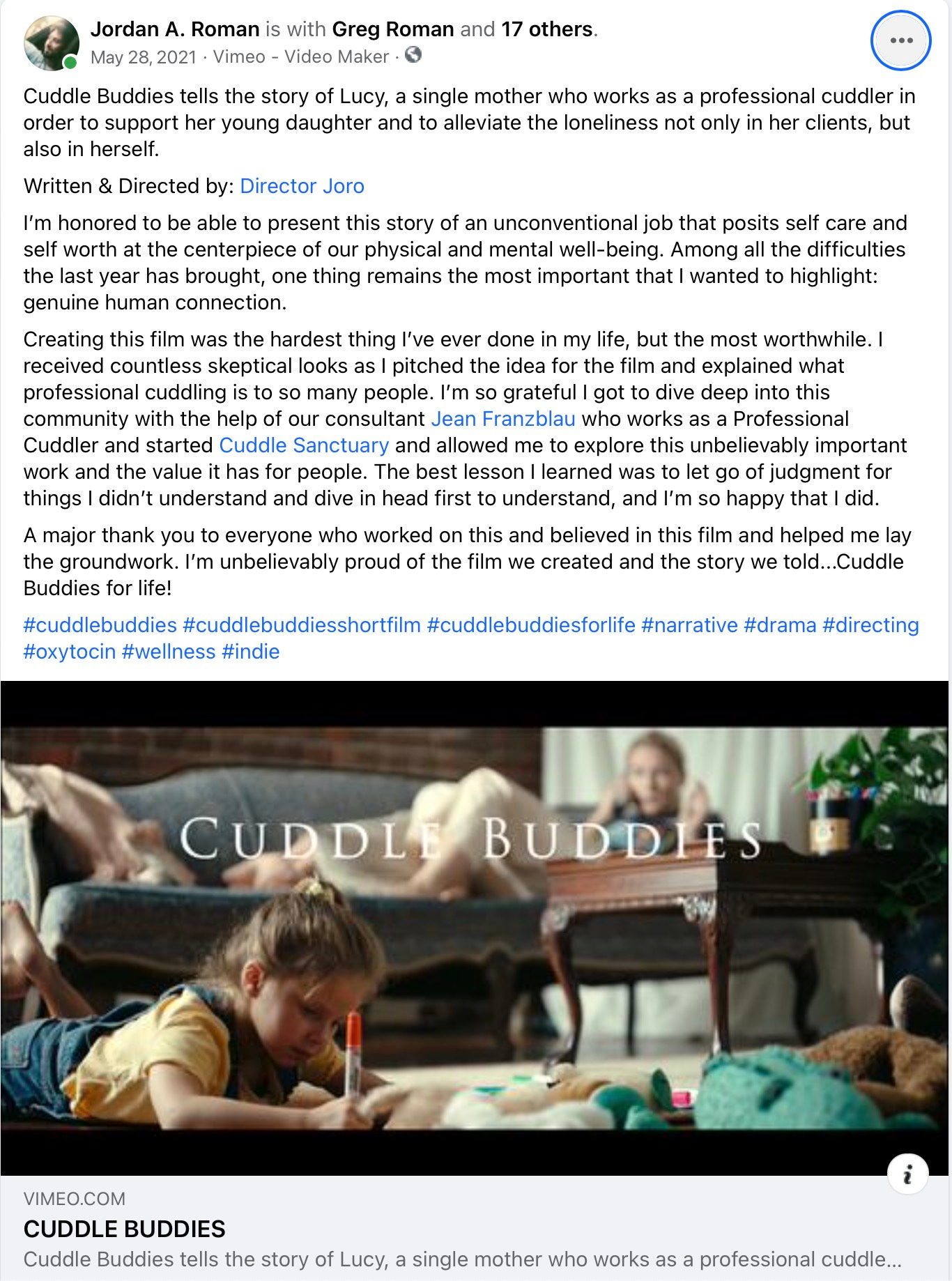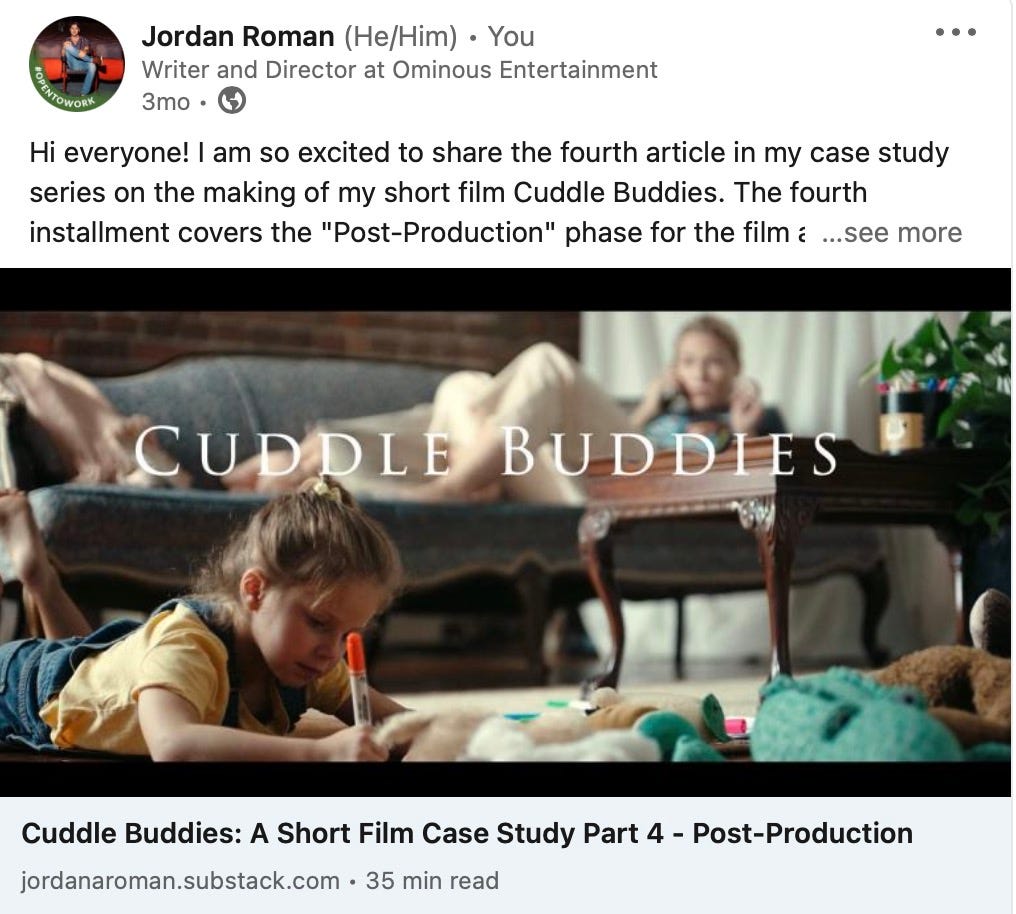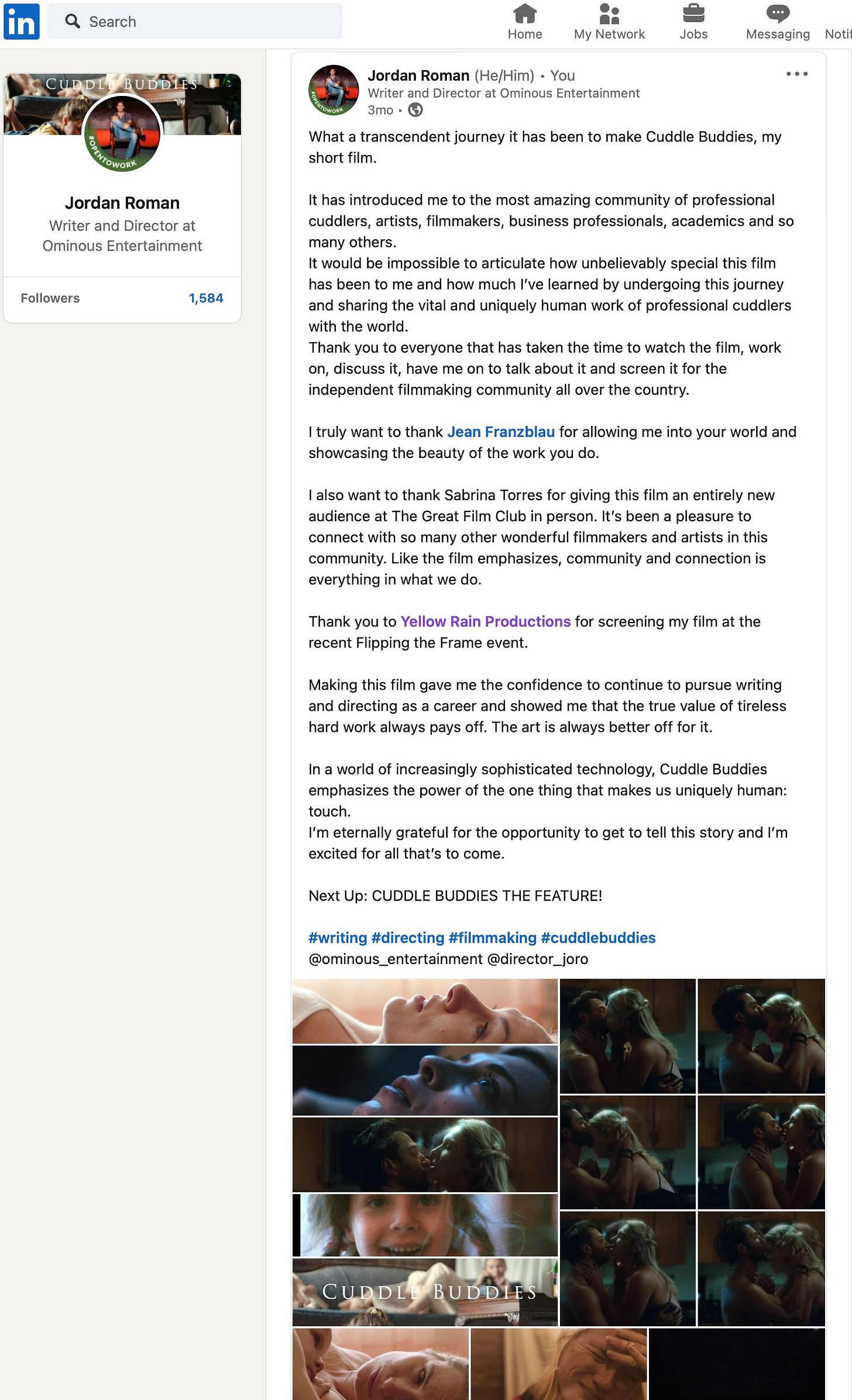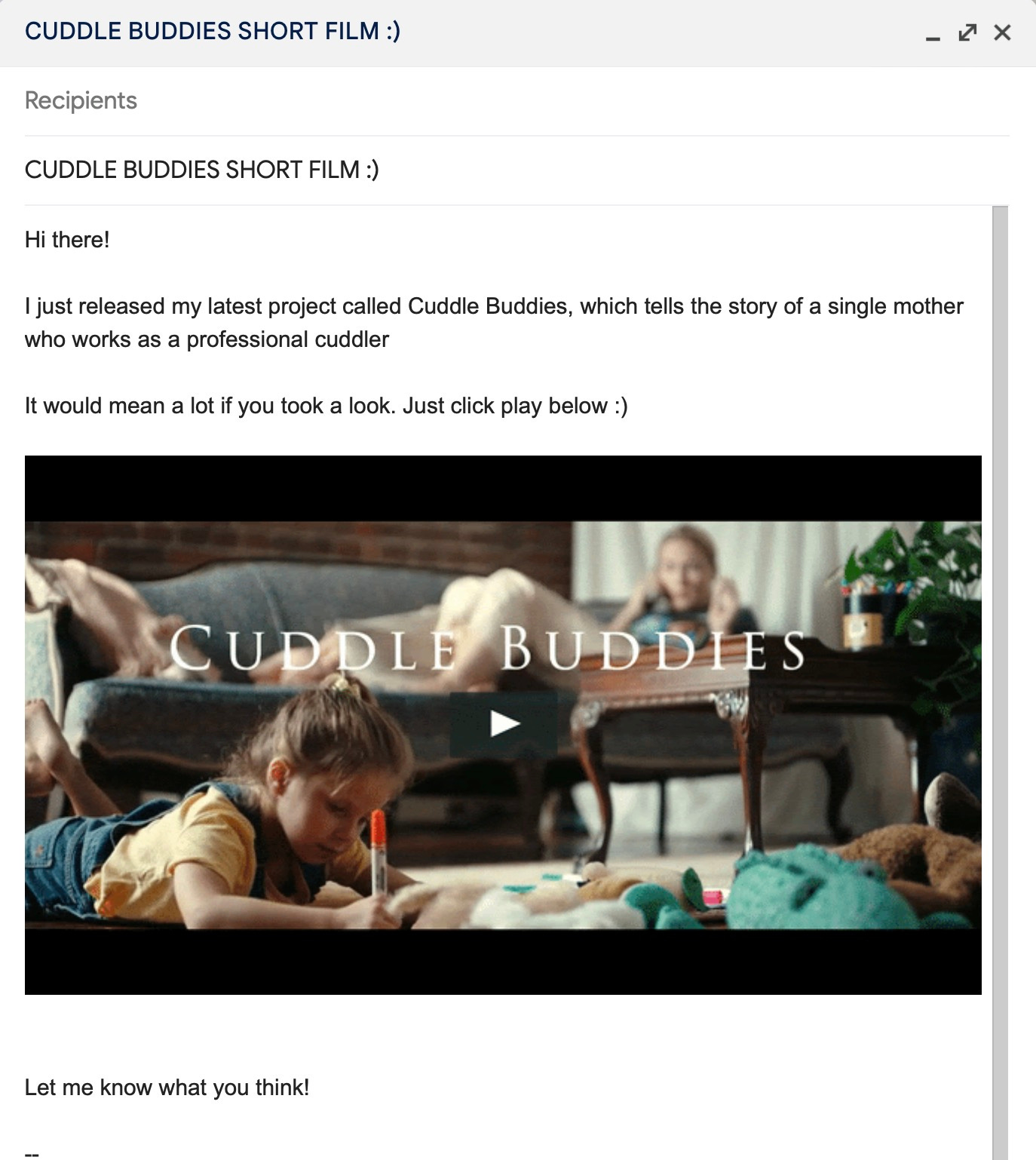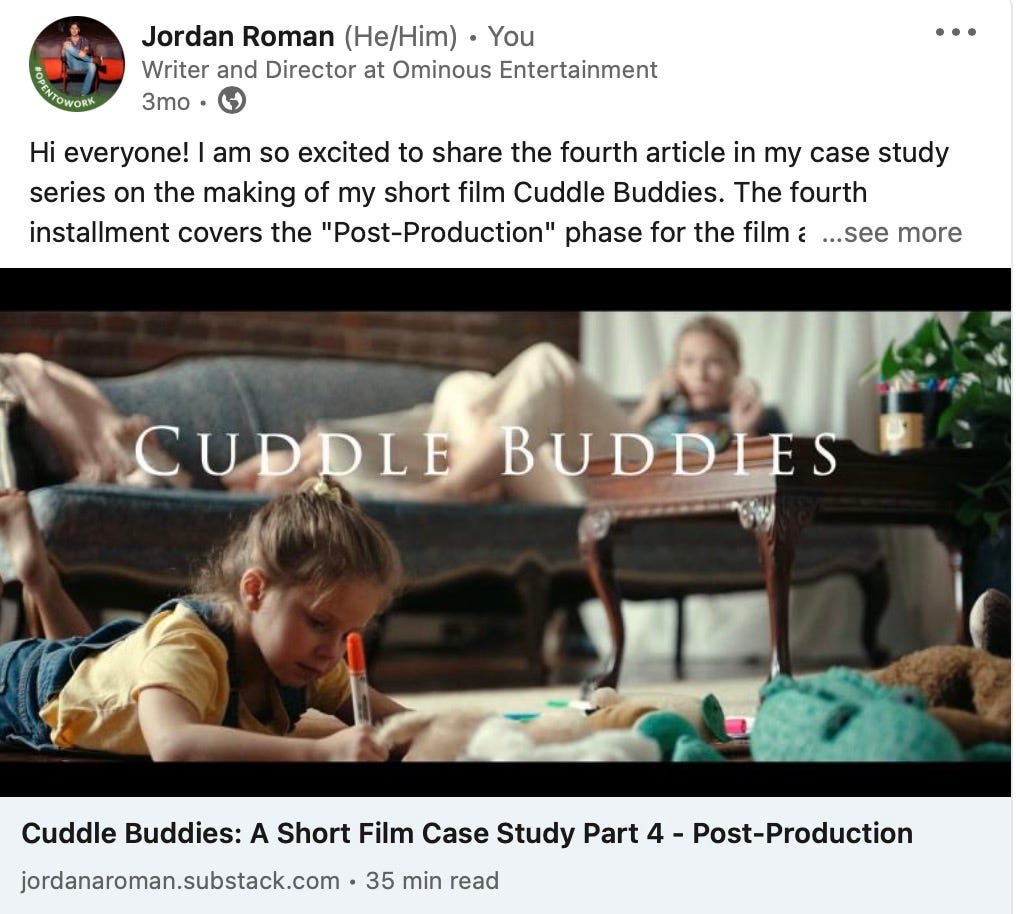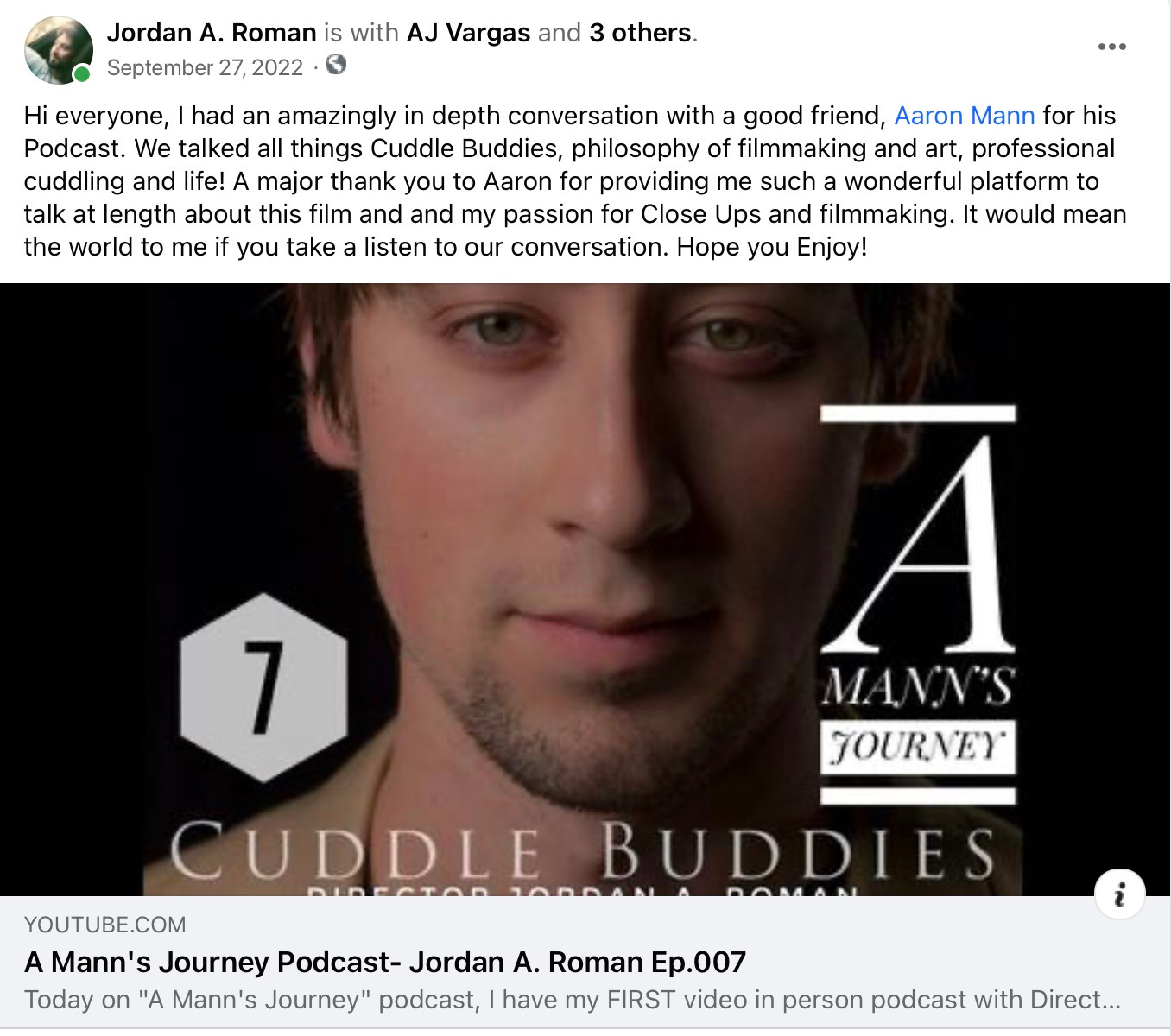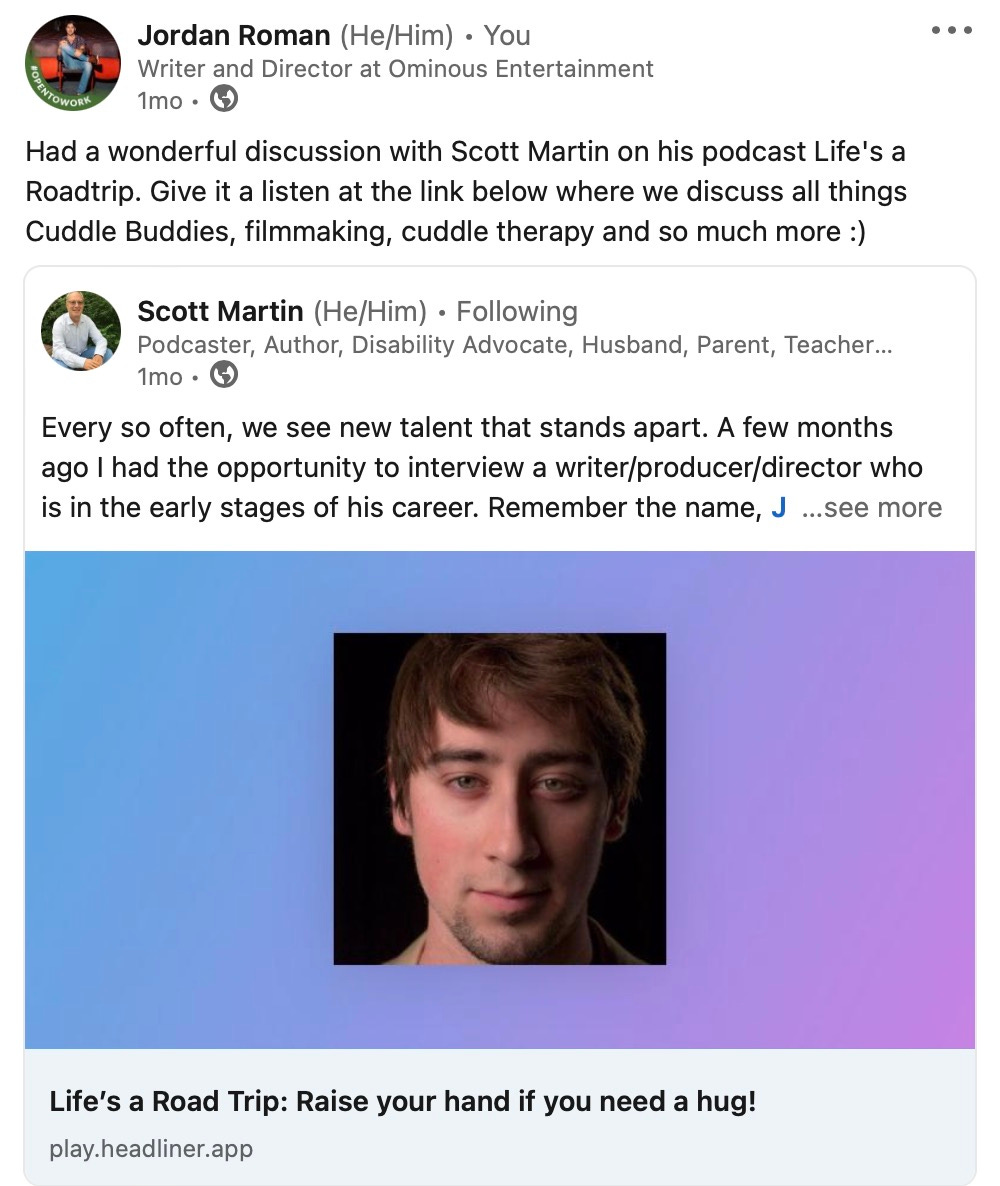Cuddle Buddies: A Short Film Case Study Part 5 - After Post-Production: Marketing, Film Festivals & Developing the Feature
The Fifth & Final Part in a series of articles on how I made my short film Cuddle Buddies as writer, director and producer, from the writing phase all the way through post-production and beyond.
Previous Installment:
Cuddle Buddies: A Short Film Case Study Part 4 - Post-Production
Previous Installment: The Short Film Here’s a link to the completed film, which serves as a great reference and context for all of the posts and discussions previously and to follow. Here is a link to the third article in this series. I highly recommend checking that out along with Part 1 & 2 since it serves a logical progression and context for this fourt…
The Short Film
Here’s a link to the completed film, which serves as a great reference and context for all of the posts and discussions previously and to follow.
Here is a link to the fourth article in this series. I highly recommend checking that out along with Parts 1, 2 & 3 since it serves a logical progression and context for this fifth part.
What is Cuddle Buddies?
Cuddle Buddies is a narrative dramatic short film that is independently produced and character driven. The logline is as follows: Cuddle Buddies tells the story of Lucy, a single mother who works as a professional cuddler in order to support her young daughter and to alleviate the loneliness not only in her clients, but also in herself.
I wrote, directed, edited, produced & colored this film and it very much was a labor of love in the truest sense of the word.
Why a Case Study?
The process of creating this film and seeing it through from the idea phase to the physical production and completion was an extremely difficult process and journey, and there were a slew of pitfalls I only wish I had known before embarking on the making of this film.
I fully realize that filmmaking is very much an art that requires you to learn and make mistakes as you do it, and the doing of it will always be the most essential ingredient and teacher. But if I can shed some light on some things I learned along the way, even if just to function as an educational tool and save any aspiring filmmakers working on upcoming projects, especially short films, the heartache of additional stress in the pre-production and production phases, then I have achieved my goal in documenting the entire production process through this case study.
OK so with that setup, let’s get into the fifth and final installment of this series, which focuses on what happens after post-production is complete, including how to submit to film festivals, how to market your film and develop it from a short into the feature film version to pitch.
After Post-Production…
Now that the film was fully complete, the next step was to figure out how to get the film seen. As they say, making a film is half the battle, and the other half is getting it seen.
To Submit to Film Festivals or To Not
Throughout the pre-production and development phases, I had generated a running spreadsheet of film festivals I knew I wanted to submit to and I aimed to include a mix of larger festivals such as Sundance or SXSW, and then a handful of mid to smaller sized festivals that had specific niches that Cuddle Buddies fit into as far as genre and subject matter to increase our chances of getting in.
I continued to update this spreadsheet continually as we went, and I included details such as the title and location of the festival, the submission and notification deadlines and the submission price and any other applicable info within the spreadsheet for ease of tracking. I also updated the color coding on the spreadsheet whenever we got into a festival or if we didn’t and you can find our final festival spreadsheet HERE for reference.
Utilizing the website Film Freeway is the easiest way to submit, track festival deadlines, submission fees and the status of your submission to any of the festivals you have submitted to. I submitted my film to every festival I applied to through this site, though for major festivals such as Cannes, you still have to submit through their own website with a separate application process.
Admittedly, my least favorite part about film festivals is the excessive amount of money you spend in submission fees for the potential of not getting in. I’d recommend to get very specific and targeted and only submit to a select few that you really believe it has a chance of getting into or really fills the niche of what your project is about.
I’ve learned firsthand that spending thousands of dollars in submission fees with no benefit to your film getting seen or recognized is truly not worth it. I’d honestly recommend re-routing that budget back into social media ads or through self promotion online and with family, friends and industry colleagues.
You could also organize your own screening and invite everyone you know. Or, you can hire a good PR person who truly can market the film and get it seen on a much wider scale than it probably would at festivals. The money spent on multiple festival submissions would be the same if not less of the cost of a good PR professional who could really do a lot for your project, since your film is their sole focus to promote.
Unfortunately a festival does not have the same incentive nor investment in your film as you ever will. This is something I only wish I had done way earlier after post-production on Cuddle Buddies. I probably spent upwards of $1,500 in submission fees to festivals. That is a lot of money that could and should have gone into a more targeted and robust marketing strategy for the film to be seen more widely and I believe it would have at the start if I had done this. Of that $1,500 spent, we got into a few festivals in total that honestly didn’t lead to anything tangible from a career advancement standpoint, though I did meet some amazing people along the way that I still keep in touch with. Meeting these people was amazing, but the money spent for it was not amazing.
This principle especially applies if your short film is 10 minutes or longer and is not a horror film. The horror film market seems to be pretty robust still within the festival space in recent years. This might be a controversial stance, but I truly believe it’s possible that a lot of short films over 10 minutes don’t often get watched by programming teams at short film festivals. I believe this is a way to consolidate time and resources, since prioritizing the shorter films allows a higher number of them to be able to fit into the viewing blocks, and hence drive more filmmakers attending and more tickets to be sold. I realize this is a bold statement so if anyone has had a more favorable experience with film festivals, please feel free to comment or write to me and let me know how it went. I’d love to hear another perspective.
Another thing to watch out for is scam film festivals that claim to have an “online film festival” and take your money without ever having a real festival and no in-person event or networking to come out of it. You will only lose money on these and you’ll often know right away it’s one of these if they are emailing you to submit your film to their festival and it’s one that has the word “awards” in the title or is one in another country with a name you’ve never heard of. Please do your due diligence in researching festivals before submitting.
One other note about submitting to the heavy hitters like Sundance, SXSW, Cannes, etc., Is that it is extremely helpful to know a programmer or someone on the inside when submitting. That or if you have a big star or name actor in your movie, your chances go up exponentially for getting in. I know this is an extremely obvious statement but I state it because otherwise you could be throwing away precious budget that could be used elsewhere.
Unfortunately the reality is that over the years a lot of these independent festivals have come from focusing on the new up and coming talent to catering toward the pre-established actors, directors, and production talent. The fact is, it is very rarely the case that films with no known entity or relationships have as high a chance at getting in. I would never discourage someone outright from submitting to a film festival, but I write this with full transparency of years of submitting to festivals with no major benefit to show for all of the money spent on them.
One major positive though is they can be fantastic networking opportunities to meet other great filmmakers, future collaborators and friends. Especially at the big film festivals, you can run into some truly amazing people, as I have had the chance to throughout the years. But I’d recommend going to festivals more with that mindset of using it as networking, even if you don’t get in, instead of putting all of your faith into the festival to truly transform your career.
Another benefit to self promotion is that it gives you more chances to hone your pitching skillset and get comfortable pitching to many different people, and it also allows you to immediately start promoting and screening your film online and in person. Whereas, if you run the festival circuit, you have to wait at least a year before you can publicly release your film or you run the chance of disqualification to most festivals. I’d say capitalize off the momentum of finishing your film and dive into promoting it right away, especially if it’s a timely theme in your film that runs the risk of going irrelevant in a years plus time.
I do want to highlight two film festivals that Cuddle Buddies got into that were favorable experiences. Cuddle Buddies screened at the Burbank International Film Festival at the AMC theatre in the Burbank Town Center and at a festival called the New York Indie Shorts Awards festival in New York City.
It was a pretty special feeling to be able to watch the film on a big screen with friends and family and with other filmmakers in attendance. I was particularly impressed with the entire team, communication and organization for the New York Indie Shorts awards in NYC and highly recommend submitting there if you do plan to submit to a great festival that truly champions independent and unique films and artists of all runtimes and subject matters. The other shorts in the block were fantastic and the cocktail reception afterward introduced me to some wonderful people.
KEY TAKEAWAY #1: Concluding the discussion on festivals, I am not against film festivals or submitting to them, but I truly do believe having a very specific strategy and submitting to a select few of them, as an independent filmmaker with a lower budget, is a much smarter and cost-effective play.
Some Additional Thoughts on Marketing & Self-Promotion
If you decide to submit to festivals, it will be at least a year until you can publicly release your film online or screen it and if you don’t then I’d immediately plan out your online release strategy. Either way the following should still apply whether you do the festival circuit or not.
Talk About Your Film to Everyone
Oftentimes the cheapest and easiest marketing tool around is to tell people about your film. I think it’s smart to keep it to the standard elevator pitch and keep it brief while also emphasizing the major elements and why your project is unique.
Of course there are times it’s not appropriate to alter the course of a conversation to tell people about your work, but there are typically many opportunities to organically work it into any social interaction or conversation even amongst friends and colleagues.
If you live in LA especially, it’s a very common question that people will ask you about your work or what you’re currently working on and that’s a perfect opportunity to genuinely tell them about the film, but simultaneously act as a promotional tool because that person will often ask to see the film or hear more about it afterward. Now, the truth is that a lot of people who ask to watch it will not take the time to watch it, but marketing has and always will be a numbers game so keep doing it. I also want to stress about doing this genuinely, and if the conversation doesn’t come up, I wouldn’t force it.
Throughout the entire pre-production and post-production phase, I must have told hundreds of people about Cuddle Buddies, so much so that I could repeat the pitch virtually in my sleep for how many times I had described it. This proved to be extremely helpful though since it helped me practice and hone my pitch for later on and make it leaner and more confident. The other thing it helped me test out was the market viability for the film and its themes. Thankfully, every time I told someone new about it, they seemed to genuinely want to know more about cuddling and my film in turn.
If you’re pitch isn’t garnering consistent interest when you tell it to people, consider re-working your description and looking at other elements of your film you can focus on or angle in your elevator pitch that will keep people’s interest when they hear it. This is a great way to beta test your pitch and increase the chances of getting your film green-lit in the future.
I’ll discuss this in more depth later in the article, but as I started to develop and expand Cuddle Buddies into the feature version, having this rock solid pitch really came in handy when I started pitching it to development companies, financiers and producers. By that point, I was confident and prepared and enjoyed those pitch meetings much more, since I was able to have fun with them and genuinely connect with the people on the other side of the Zoom calls hearing the pitch.
KEY TAKEAWAY #2: Think long and hard about the best way to angle and pitch your film from a marketing standpoint to grab and keep people’s interest. Even if your film is already complete and the subject matter sounds mundane, the way you pitch it can be electrifying and should be. (Along with the execution of the idea in your film. That should be too.)
Releasing Your Film Online
Let’s assume that now the time has come to release your film online. I strongly advise spending a lot of time creating a specific and strategic marketing plan in the months and weeks leading up to the day you plan to share the film link publicly.
You want to have at least a handful of post ideas for all social media platforms and the necessary key art (stills from the film you want to include in the posts). I find it extremely helpful to even create a basic schedule of when you want to make posts including the ideal dates and what kind of posts you want to make.
For Cuddle Buddies, once I set the official release date in my head, in the month leading up to it I started making about 2 posts a week every week on virtually all of these platforms to create a “countdown” to build buzz leading up to the release date. It’s crucial to also note the actual release date in all of your posts and continue to remind people on every platform. Make it so there is no way people are unaware that your film is coming.
The next step was to get the link ready. Roughly a year after finishing post production on the film and after the festival route, I was finally ready to release the film. I uploaded the highest quality export that I could to Vimeo. I highly recommend using Vimeo as the platform to upload your film to and the Vimeo link being the link you send out to everyone. There is much higher preservation of your film’s cinematographic detail and it presents it at a much higher quality than YouTube, which highly compresses your film. This is also the link you will be using for anytime you share your film through all of the social media platforms discussed below.
Now that you have the link ready, get ready to blast it out!
Social Media Marketing Strategy
I want to preface this section with the fact that I am not a marketing or social media expert, but I can relay some of the tips I used in promoting Cuddle Buddies on these platforms that proved to be helpful for me.
I’ll include examples of posts I made and some strategy I utilized for promotion on each of these platforms listed below:
Instagram
Instagram is a very visual focused platform so it is crucial to post any videos, clips of your film, stills from your film, etc that can be watched and drive visual interest to your project. I focused a lot on pushing my favorite stills from the film, along with promoting the trailer to the film and splicing certain scenes or sections from the film to post, since the full film was far too long to include in a post.
I think it’s important to include the most visually striking, shocking or thought provoking imagery that you can in your posts. For one this will grab attention, but it will also separate your film from every other film being promoted or posted that users will see scrolling down their feed.
For Cuddle Buddies, I really leaned into the professional cuddling component of the film, mainly because it is such a unique and different type of job and I figured it would separate the film out from any other film being promoted at the time. I focused on posting about the profession of cuddling, and included film stills of Lucy cuddling with the clients, pointing out cuddle position names in the captions, and emphasized words like “Oxytocin” and “touch”, especially because at this time, the Covid lockdown was finally starting to lift and physical separation had been so prominent and I wanted to emphasize the importance and need for connection, when we had all mostly been feeling disconnected during the lockdown.
KEY TAKEAWAY #3: While promoting, never fear that you are bothering people by posting and reminding them of a release. The fear of bothering will lead you to miss the valuable promotional window and the same principle applies to the financing and fundraising process while in development too. You’d be surprised how often your community simply misses the memo because of how much other content is bombarding them at all times. Let people know about your work. I was and still am continuously surprised by how many people still didn’t know I’d released the film even a year plus after posting it all over the place.
I posted clips and stills of the “cuddle montage” split screen section, where the frame splits into four different frames since it was a very experimental and visually striking set piece within the film that I figured would draw some attention to the post due to the visual flair. In addition I posted a lot of stills from the film that included more artistic or experimental visuals that I found striking, including a shot that I love of Lucy and James kissing as their “ghosts” appear to emerge as an outer spiritual layer from behind their heads.
To create more audience engagement I also made sure to ask people what they thought of the film, or of cuddling or cuddle positions. Any questions you can ask to drive engagement is extremely helpful and this applies on all platforms.
See some examples below:
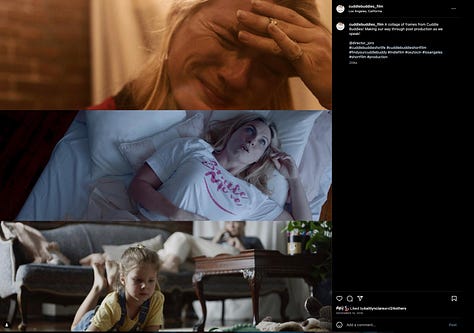
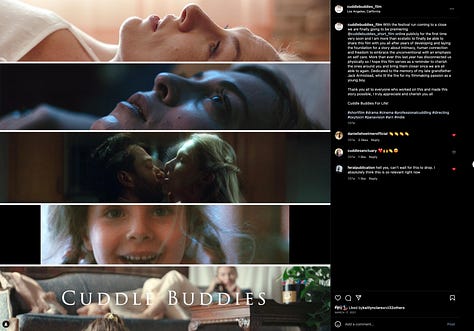

The other component I really pushed were stills of the characters of Lucy and Marina cuddling together or just Marina within the film. I figured that seeing a mother and daughter cuddling or just an adorable little girl would drive interest and Lorelei Olivia Mote, the six-year-old actress who played Marina, was so wonderfully heartwarming in the role, that I realized this would also drive interest and a genuinely heartfelt investment in the film and it’s characters. Similar to when you see an adorable kid or animal in a film, it tends to stick with audiences and this was something I emphasized in my posts, seeing as this was also a factor I realized would land even as I was still writing and developing the script and characters.
See some examples below:
KEY TAKEAWAY #4: ALWAYS think about how to distinguish your project from everything else out there. It has to rise above the rest of the noise to stand out and you should think about this while writing and creating your film as well. The easiest way to do this? Don’t follow the trends. When everyone else is using one particular type of shot, software or gear, use a different kind. When everyone else is going left, go right. This will always help you rise above the crowd.
Tik Tok
With TikTok, short and sweet videos are obviously the name of the game. I have significantly less experience promoting through TikTok, but my approach was essentially the same as through Instagram: keep it visually focused, but with even shorter clips.
I picked out those couple clips I wanted to push and trimmed them down to be under a minute if I could, though one or two of the videos were slightly longer.
I focused on the “split screen cuddle montage” and the “family montage” sections along with posting the film’s trailer. I added some font on each video to really single out the main focus of the video and I also made sure to shorten my captions, since Tik Tok is even more visually influenced than Instagram.
See some examples HERE, HERE and HERE.
FaceBook (Meta)
Though FaceBook or “Meta” has increasingly strayed from becoming the main platform for Millenials and Gen Z, I will always promote my work on there too in order to reach a different audience of predominantly older generations.
For these posts, I’ll usually post the Vimeo link to the film on my timeline along with a brief caption to introduce it. I also tag any other actors or crew who collaborated on the film and have FaceBook too.
Before or after making the official release date post, I like to make a few other posts that highlight my favorite film stills and ask people to engage or let me know what they thought of the film.
See example below:
LinkedIn
Over the last few years, LinkedIn has truly become an exceptional place to network professionally, even for film industry positions.
I also personally love the layout of the site and the predominantly positive messaging that fills the interface, in contrast with the increasingly negative messaging that has come to dominate Meta and Instagram in turn.
I have connected with hundreds of professionals inside and outside of entertainment through LinkedIn and sometimes those outside of the industry can be just as valuable as inside. I started posting all of my films and work on LinkedIn and noticed a substantial increase in viewership to my work and profile since doing this.
LinkedIn tailors toward a more professional and educational type of post and so in promoting on there, I really try to emphasize more of the educational components. For example, I’ll post stills or a link to the project and in the caption I will detail how I made the project or point out specific software, technical tools, equipment or the workflow I achieved to complete the project.
A great example of this is this very article you are reading, are all linked to my LinkedIn profile home page. In addition to educating how I made the film, it acts as another fantastic promotional tool for people to watch the film, so they can follow along to see how the film they watched came together behind the scenes.
I’ve also had the fortune to go on a couple podcasts to talk about the film and I also will always link those discussions in a post and tag the host so it can cross-promote both of our profiles. More on podcast promotion below.
See some examples below:
Email Lists
Don’t underestimate the power of email lists and utilizing them to email blast your film link out to everyone you know. I’ve always personally observed a higher engagement ratio through email than any other specific platform.
The easiest way to start is to create a Google spreadsheet and compile all of the emails of your friends, family, coworkers, former professors, etc that you would feel comfortable emailing and list all of their names in one column and list their email in the next column. If you export this out as a .CSV file, a lot of mailing list sites such as MailChimp, TinyLetter or Substack can read the CSV and streamline the email process to automate the delivery process. You can also just copy all of the emails from the spreadsheet and paste them directly into the recipient box of an email as well.
Any time you add new emails, just update your spreadsheet and import an updated CSV. I like to constantly add new people to it every so often when I meet new colleagues or friends who I think might be interested.
Again, don’t be afraid to promote your work and share it with people in your community. It’s so worth it and in the worst case scenario, someone can unsubscribe if they really want to.
Often times because email is more professional and goes directly to someone’s inbox, they are much more likely to see the link, take a moment to watch it and even reply back with comments.
When I finished Cuddle Buddies, I immediately put together an email list that included friends, family, old co-workers, along with college and high school professors who taught me filmmaking in the first place. These are all people who I figured would probably love to see what I went on to do, and many of my professors did email me back with wonderfully kind words and encouragement.
Once the Vimeo link was ready, I assembled my email list and crafted an introductory email message with the link to the film, which you can conveniently embed from Vimeo into a GIF right into the body of the email, which I find looks much more elegant and appealing. Then I sent it out for everyone to see!
I’ve found that it’s become much easier to promote as I keep doing it. I’ve abandoned much of the worry about being bothersome with sharing my work and at this point I’m much more confident now to send emails out any time I release a new project and am very excited to do so. The response from people in your community makes it completely worth the effort.
Here’s an examples below of the email I sent out:
KEY TAKEAWAY #5: Email might still be the best marketing tool of them all when running your own marketing campaign as an independent filmmaker.
Substack
Most of the promotion I do through Substack comes in the form of longer form essays that detail the making of the film. A great example is this article you are reading. This functions primarily as an educational resource, but it also serves a great secondary function as another marketing tool to showcase the film and drive web traffic to the link, since the film serves as the central basis for every facet of the discussion of each of these articles that all detail the process of how it got to the final product you see at the link.
Substack, in contrast to Instagram or Tik Tok, is the platform where you can expound in great detail about the technical elements of the filmmaking and it gives you the chance to write in long form with greater depth about each topic and frame that was created.
This certainly caters to a more specific niche demographic that skews toward the technically and process oriented individual, for current students, or the up and coming filmmaker that might seek to learn how to produce a short film post graduation. My primary audience was always the current students and young filmmakers when I set out to write these articles, but the great joy has been in finding that people of all types have taken the time to read and left wonderful feedback.
Much like the email lists I discussed above, whenever I publish a new article, I embed it within an email that get sent to everyone on my email list. Doing this serves to promote not only the article, but the short film as well.
I also link my new articles through Facebook, Instagram and LinkedIn as well since all of these platforms feed into each other and you never want to leave one facet of your audience out that you can market to.
Substack is truly the best platform to showcase the breadth of thought and care that goes into making films, and the people who end up reading, will really be won over, since they can see your passion on full display.
Here’s an example:
Podcasts
A little further into the release timeline after the film had been shared online for a little over a year, I had garnered more views and awareness and through posting one of the film’s promotional clips on TikTok, a good friend Aaron Mann reached out to inquire about discussing the project on his podcast.
Aaron is a great friend and fellow artist and his podcast, “A Mann’s Life”, explores the creative process as Aaron talks to fellow creatives about their work and process. Aaron and I discussed the podcast format and we ended up deciding to shoot video of our conversation while we also recorded the audio.
We set up a shoot at his apartment and had an incredible conversation that lasted about three hours. Aaron is such a great interviewer and he asked incredibly detailed and technical questions that allowed me to expound in great depth about every detail of making the film. That was truly a gift. Please be sure to check out our full video conversation HERE and also on his podcast page for “A Mann’s Life” HERE.
A few months later, the generous Scott Martin found my work on LinkedIn and emailed me to set up an interview about the short on his own podcast called “Life’s a Roadtrip”, that interviewed many people with disabilities about their journeys and overcoming their hardships. Scott wanted to learn more about professional cuddling, touch therapy and how it could certainly act as a source of comfort to people of all types, disabled or not.
Scott and I had a wonderful discussion and he has continued to be such a champion of the work and art I create so a major thanks to Scott for that. Check out our discussion HERE and definitely be sure to check out his other discussions with a variety of fantastic guests on his podcast page.
Both of these opportunities allowed for more opportunities to continue to market and share the film, but it also allowed me to connect with some amazing people over such genuine conversations.
The Great Film Club Local Screenings
Perhaps one of the best promotional pushes in person that ever happened to Cuddle Buddies was when I met filmmaker Sabrina Torres, also known as Sabrina the Great, which perfectly sums up the incredible value she adds to the LA independent film scene.
I met Sabrina at a brunch filmmaker meetup and she had just recently launched her very own film screening club called The Great Film Club. At the time her club had a monthly “Short Film Open Mic”, where filmmakers of all backgrounds and skillsets could submit and screen their films for an audience and then mingle afterward to discuss.
I loved the idea and as I pitched her the logline of Cuddle Buddies, she immediately told me to submit. The very next day I emailed it to her and she programmed it into the next month’s Short Film Open mic night.
Attending this Open mic night was an absolute blast and gave the film a chance to screen in person with an entirely new audience, which is the biggest gift a director could ever have.
I got to meet so many wonderful creatives afterward and got some incredibly kind reception to the film, which only helped to “market test” the commercial viability and prove to me that this was connecting with audiences in person.
Sabrina is such an indomitable champion of independent filmmakers and truly creates community unlike anyone else.
Sabrina has become a great friend and has graciously programmed Cuddle Buddies two more times into different local screening events around Los Angeles. I’m not exaggerating when I say that she has given the film an entirely new life and audience in person that never would have gotten to see it.
For that I am eternally grateful. Check out her Film Club Website HERE, where you can grab tickets to upcoming screening events and also submit your own short films and projects if you are a filmmaker too. I can’t recommend it enough.
Screening your films in person does three main things:
It tests out your work with an audience and quickly lets you see how well or not your film connects and can move an audience or not. This is the best teaching tool.
It promotes your film in the best way, since audiences are able to watch it and are guaranteed to see it in the best viewing environment without distractions or skimming it like they could at home.
It helps you realize if your film has market viability beyond the short and has potential for a feature or television format for proof of concepts.
The unfortunate reality is that a lot of people that ask to see your film won’t actually watch it. Screening it in person guarantees that they do and gives you the validaton to celebrate your work in its fully glory.
By screening the film multiple times in theaters with audiences, I was also now fully confident that since the short was connecting with audiences, I truly believed a feature version also would.
After enough audience members asked “what happens afterward?”, I knew it was time to pursue the short as a full length feature film.
KEY TAKEAWAY #6: In-person screenings are the most rewarding form of marketing and celebrating your film and the hard work that went into it. Don’t underestimate the magical theatrical experience.
A Few More Takeaways for Marketing
KEY TAKEAWAY #7: Tailor your posts and strategy for each respective platform to take advantage of the different strengths that each one offers, so you can best utilize and expand your reach as widely as you can with your entire marketing strategy. By also utilizing all of the major platforms to market your film, you truly are expanding your exposure to many different people who would only be exposed to it on one platform over the others.
KEY TAKEAWAY #8: Be sure to continue to update your posts on all of these platforms continuously, especially after you do the official release. Any time there is a new development in the life of a project, such as a festival acceptance, a local screening or panel, or it being developed into a feature, keep people updated by adding fresh new posts to all of your platforms. The marketing never really stops until you move onto your next project.
Developing the Short Film Into the Feature
One of the most difficult challenges I have ever faced was adapting the story of the short film into the full length feature version on the page. Because I had never initially intended to pursue Cuddle Buddies as a feature film, I wrote the short to virtually include it’s own beginning, middle and end. In my initial plan, I planned for the story to live and die by the short.
Years later and now well into the development phase of the feature, one of the best lessons I learned was that I initially should have planned out the feature version first and then extracted a section to be the short film proof of concept. I think in this way, adapting it into the feature would have proven to be more seamless. However, hindsight is always 20/20 and I also believe I wouldn’t have taken the big creative swings I took with the short, had I known what the longer story entailed. So I think it all worked out in the end.
What made the adaptation so difficult was mostly the fact that I felt I had said everything I wanted to say in the short and so figuring out what I still wanted to address in the longer format was far from a sure thing in my mind.
There were also many different directions the feature could explore, based off the existing threads that were created for the short and I had a variety of conversations with family, friends and industry colleagues about interesting ways to take it. I was also truly searching for the “right way” to continue the story and still keep the tone and characters faithful to the world of the short. It felt like an immense amount of pressure to live up to.
Outlining and Drafting the Feature Script
I took a few months to brainstorm all ideas and directions the feature version could go and then took another month to write down an initial outline of how I saw the structure going.
My first outline pursued the film as basically a 2-Act film, whereas we explore in the 2nd half what happens to the daughter Marina when is now grown up and navigating the world as an adult in her early twenties.
I spent about 8 months writing the first draft and laboriously expanding out and the world and attempting this version of the story. The first draft clocked in at around 162 pages and ultimately did not work, mostly due to the immensely difficult way to make a 2-Act structure within a feature work, especially when you change protagonists from Lucy to Marina half way through the story.
The issue was the story also started to veer into a very different kind of film and away from the heart and soul of what made the short work in my opinion. The dialogue around cuddling and touch and the core group of characters started to get lost and internally I knew it didn’t work.
A big lesson I also learned in adapting the short into a feature script is that it’s OK to let go of certain scenes and characters that were in the short. Sometimes in the longer format, some of those elements just don’t work and end up hanging you up in the writing. Letting these go can allow you the freedom to let the feature be what it wants to be. Realizing I could let some of these elements go while still retaining the heart and soul of the story and tone was a big breakthrough in helping to understand the best structure for the film I was trying to make.
A great gift I had was being a part of a writer’s group that included two friends, Cameron Jackson and Frankie Campisano. They both looked over two different passes of the script and gave invaluable notes every step of the way to reformat it back into a 3-Act structure that really focused on Lucy’s journey and sustaining her internal tension of self-actualization, along with navigating her own intimacy with her husband James and daughter Marina, while spanning a much shorter number of years to keep the audience more firmly centered in a short but critical time span of her life in the story.
Frankie’s unwavering commitment to helping me strengthen the script and time spent reading every single draft since then has been absolutely saint-like. Frankie’s meticulous eye for detail as a fellow writer truly pushed me to polish every single piece of the puzzle and take the feature draft to an entirely new level.
Through Frankie’s help and through re-outlining countless times, I discovered that the best way to tell this story was to rewind the clock and start the film back to before Lucy became a professional cuddler and establish how she fell into this line of work and then proceeded to let cuddling transform her life and ability to ultimately become a better wife and mother.
I’ll admit this process has been unbelievably grueling and tiresome, but seeing how far the script has come and how much better of a film it will be before production always makes it worth it. It’s helpful to take time away after each revision and then dive back into it with fresh eyes. There were many times I considered the script ready, only to come back later and realize it still wasn’t there yet.
Taking the time to hone your story and script over and over again while you are able to always makes the movie better in the end. The commitment to excellence truly shows in the end product. Great movies are made by this principle.
The current draft is revision #8 and I plan to do at least a few more small polish passes before production, but this current draft is the one we feel is ready for pitching and selling.
It’s been a year and a half of just the writing phase for the feature and that time spent honing it has been worth every second.
KEY TAKEAWAY #9: Truly take your time writing the feature script and then revise, revise, revise! Don’t move forward with budgeting, scheduling etc until it’s ready to go.
The Development Phase: Budgeting, Scheduling and Preparing the Pitch
As the script got closer and closer to completion and it felt stronger with every revision, I started to get serious about assembling the materials to create the strongest pitch package that I could.
A standard feature pitch package is comprised of a finished script, a preliminary schedule and budget, the short film if available, and a PDF pitch deck that showcases the business plan, similar films, financing strategy, team members and the talent you are pursuing for the principal roles. Here’s an example of one for reference.
All of these elements are what you would normally walk into a pitch meeting with to hand out for reference while you verbally pitch the film and make the case for why make your film now and why you are the best person to make it.
Great pitches can answer all of these questions along with how investing or acquiring the film will be a great business deal for everyone involved and guarantee a good return on investment.
Many months went into this development phase of listing out the dream cast wishlist and further refining it to also provide ample backup options for every major role.
As a writer and director, it was convenient for me to be able to think like a director and consider all of the technical and logistical elements of production as I wrote and got further into revisions. A lot of later revisions included simplifying and making elements more affordable for budget reasons.
Along the way I’ve made copious notes on the cinematography and shooting style, the locations desired, my vision for the score, sound and editing rhythm and crew and department heads that I think will make the strongest team to achieve the vision.
I’ve also spent months studying the business market and financial models, along with researching specific production, streaming companies and studios that make similar films to what I envision mine will be like that I can aim to pitch to for a better chance of getting green-lit.
All of these elements make their way into the pitch deck eventually that you present as a part of the pitch and strengthen your marketing angle to sell your film in the most persuasive way that makes it a no-brainer for any company to get on board with.
For an example, one of the films I’m using as a tonal and box office reference is the film Moonlight, directed by Barry Jenkins. I chose Moonlight since it is a character study of one man’s life, and also carries the same human and emotional tone that I foresee for Cuddle Buddies and even served as a good tonal reference while making the short film.
Moonlight was also made for around $4Million, just a little more than the same budget I’m looking at. It went on to make a big cultural impact, won Best Picture at the Academy Awards and did a very successful worldwide Box Office of $65.3 million against the $4Million budget. It was also made by powerhouse independent production company A24, which is one of the companies I’m targeting for Cuddle Buddies. A24 will also be in attendance at the American Film Market, which I discuss in more depth below. In this way, Moonlight makes sense as a great comparable film to include in the pitch deck and as a component of the pitch strategy for Cuddle Buddies.
KEY TAKEAWAY #10: Put together a visually appealing pitch deck with clear information and great references. Make sure the imagery looks great and ties in with your theme. A good pitch deck will immediately grab attention and show the professionalism that you know what you are doing and that the film will have good quality, as your materials can already showcase. A bad pitch deck or poster often means the film is also bad.
Preliminary Budgeting and Scheduling
Once I got serious about pitching the feature version of Cuddle Buddies, my approach was to pursue production management companies or Line Producers, who are the people who create and oversee budgets to ensure projects stay at or under budget, to get a preliminary budget and schedule created to use for pitching purposes.
This next part might sound laughable, but it ended up working wonders for me, especially as someone without representation (agents, managers) navigating this process with the mindset of a producer. I made a post on a FaceBook group called “I Need a Producer” and mentioned that I was an indie feature film, Tier 0 “Ultra Low Budget”, according to the IATSE tier system, in the range of $1-2 million budget, and needed a preliminary budget and schedule created to pitch with.
To my amazement, over 40 responses came in and over the next few weeks I narrowed them down and set up virtual meetings with nearly 10 of the respondents. I had also come across a company on FaceBook that offered budgeting and scheduling services that aimed to help indie filmmakers get their films ready for financing. This company is called TruVariety Films and I also scheduled a call with them as well.
All of the Line Producers and production management companies I met with were amazing and wonderfully kind. I pitched all of them on the film idea and then sent them the short and the amazing thing was every person took the time to watch the short, which I was very grateful for. This process also ended up becoming a great networking process but also an educational process for learning how much budget and schedules cost to create.
These preliminary schedules and budgets typically run in anywhere from $1,500 on the low side to around $4,000 or sometimes more on the higher end. It depends on the experience and standard flat rate that the Line producer or company works from. Asking this each time is crucial to get a sense of what your development costs will run.
If you have some development seed financing, you can apply this funding to costs such as these, but if you don’t, as in my case I didn’t, sometimes you have to pony up that cash on your own to invest in yourself and your potential. This is nothing new from personally investing in most of the short films I’ve directed to date, but I can confidently say that those investments have really begun to pay off.
TruVariety ended up loving the short film and the concept and offered to help me pitch it as one of the films on their slate at the American Film Market or “AFM”, which is the biggest American film market and happens every year in Santa Monica for filmmakers to pitch and sell their films to streamers, studios and production companies.
I immediately agreed to go with TruVariety to AFM to pitch Cuddle Buddies as a feature with their assistance and for that reason I went through their company as well for production management services to provide the preliminary schedule, budget and pitch deck that we utilized in the pitch.
Months and months of building this strategy and assembling the materials lead up to the opportunity where you are ready to pitch.
As I write this now, we just pitched the film at AFM and I am so grateful to TruVariety for championing the idea and every single person who helped refine the script into what it is today and helped make the short film that ended up being the best pitching tool I could dream of.
I’ve waited over seven years to be able to say that we can transform this story into a feature film and within the next few weeks we should have more info as the post-AFM dust settles. Stay tuned for more updates as I plan to continue to document the process of making the feature and will eventually write a follow up installment to update once we secure financing and enter production.
The Marketing Never Stops
The marketing never stops. To this day I am still talking about the short film, pitching it and sending it out whenever I get the opportunity. And now I’m doing the same but with the feature version.
Again, it’s a numbers game. Even as an artist, you should always be thinking about how you could sell your product. You want to give it the very best chance you can for more people to view, which drives your numbers and back end profits for all involved and only allows you to continue to make the next film and the next one.
The marketing truly never stops.
In Conclusion
That wraps up the last installment in this 5-part case study on how I made Cuddle Buddies. I sincerely hope you enjoyed this case study and learned as much from these articles as I did making the film itself.
Please feel free to comment if you have any additional thoughts or contact me if you have any further questions on the making of the film.
Stay tuned for more updates and addendums to this case study as we further develop the film and enter production. Eventually down the line, once we complete the feature version, I plan to make another case study on how we made Cuddle Buddies the Feature.
“Cuddle Buddies for Life!”





